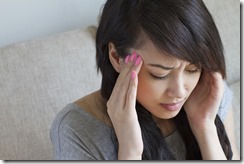 Migraines are chronic and debilitating and affect 12-20% of the world’s population, and are more common in women. Women account for about three quarters of the 28 million Americans who experience migraine headaches. Attacks can begin at any age, but they typically start during childhood or adolescence when they are pretty equal in boys and girls. By early adolescence though, the prevalence becomes more dominant in women. This prevalence of migraines peaks in women in their early forties, and then declines steadily as we age, but may not resolve completely. Migraines tend to reduce in frequency in postmenopausal women, with estrogen levels decreasing significantly and also stabilizing without monthly fluctuations.
Migraines are chronic and debilitating and affect 12-20% of the world’s population, and are more common in women. Women account for about three quarters of the 28 million Americans who experience migraine headaches. Attacks can begin at any age, but they typically start during childhood or adolescence when they are pretty equal in boys and girls. By early adolescence though, the prevalence becomes more dominant in women. This prevalence of migraines peaks in women in their early forties, and then declines steadily as we age, but may not resolve completely. Migraines tend to reduce in frequency in postmenopausal women, with estrogen levels decreasing significantly and also stabilizing without monthly fluctuations.
Only about half of patients achieve a 50% reduction in the frequency of their attacks, despite the availability of prophylaxis options. Sadly, only 3-5% of chronic migraine sufferers receive adequate prophylaxis therapy.
A randomized, multi-center, parallel-group design was conducted in which melatonin was compared with amitriptyline and placebo for 12 weeks. Patients were randomized into one of three groups: placebo, melatonin 3 mg or amitriptyline 25 mg before bed, daily. After a 4-week baseline phase, 196 patients were randomized with 65 in the placebo group, 66 received amitriptyline and 65 received melatonin. Those numbers in each group decreased slightly as 18 were lost to follow-up.
Patients were men and women ages 18-65 and had migraines with or without aura for at least 1 year and first onset prior to age 50 years. Patients were included in the study if they had at least three migraine headache attacks or four migraine headache days (a headache of at least 30 minutes in duration) per month but < 15 headache attacks over month during each of the previous 3 months prior to the screening visit. Patients were excluded if they had a past or present psychiatric disorder, used ergotamine, triptan medications, opioid or combinations of those for > 10 days per month or just an analgesic for > 15 days/month for > 3 months. They were also excluded if they were unable to discontinue their prophylactic medications, or had previously taken melatonin, amitriptyline or agomelatine or had uncontrolled hypertension at the screening visit or at randomization.
Mean headache frequency reduction was 2.7 migraine headache days in the melatonin group, 2.2 for amitriptyline and 1.1 for placebo which means that melatonin was as effective as amitriptyline in the primary endpoint of frequency of migraine headaches per month. Melatonin was superior to amitriptyline in the percentage of patients with a greater than 50% reduction in migraine frequency and melatonin was better tolerated than amitriptyline. Melatonin and amitriptyline were both more effective to placebo in reducing the number of analgesics used, and the duration and intensity of migraine headache attacks.
Commentary:
The process of migraines is multifactorial- neurological, vascular, muscular. What we now think is that it can begin when the sensitive nervous system of a migraine sufferer is faced with an environment that can reduce their migraine threshold. These risk and trigger factors include hormonal changes, alcohol consumption, skipping meals, sleep deprivation, medications, and other stressors. Under these circumstances, the neurochemical balance of the nervous system changes, and prodromal symptoms can occur. If this state progresses, the migraine threshold is crossed, and the “migraine generator” area of the brainstem is now activated. A wave like effect occurs across the cerebral cortex- neurons are affected and the trigeminal nerve branches and the vascular structures it supplies are activated. As the branches of the trigeminal nerve are activated, neuropeptides are released from the nerve. These then produce an inflammation of small arteries in the meninges which stimulate platelet aggregation and serotonin release, potentiating the migraine process. Nerve impulses are transmitted back to the brainstem and as the process continues, brainstem reflexes are activated that produce the migraine related symptoms, ex/ nausea, vomiting and photophobia. Pain fiber activation can also result in nasal congestion and pain in the sinus cavities.
While this study did demonstrate efficacy of clinical import, we can do even better. I would definitely incorporate melatonin 3 mg/day into my prophylaxis approach to migraine… in which I am intending to reduce not only frequency, but duration and severity as well.
Reference: Goncalves A, Ferreira A, Ribeiro R, et al. Randomised clinical trial comparing melatonin 3 mg, amitriptyline 25 mg andplacebo for migraine prevention. Published online J Neurol Neurosurg Psychiatry May, 2016

